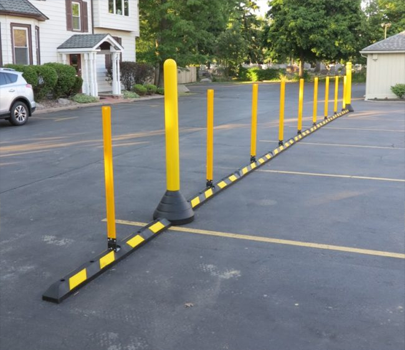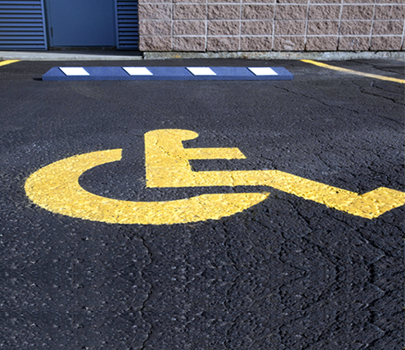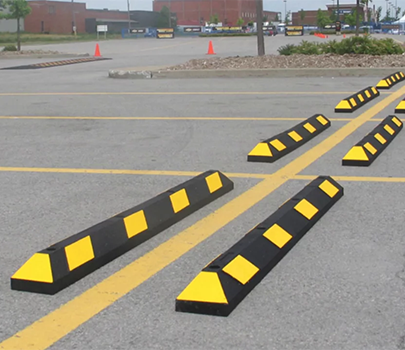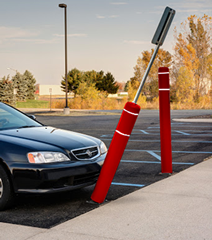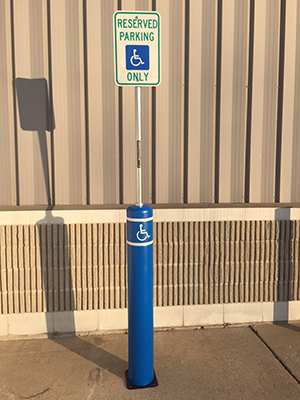The parking lot design plays a significant role in converting an accident-prone parking space into a well-streamlined parking lot, that minimizes injury and damage. Both, parking stops and bollards, form an integral part of any safe parking lot.
Often, the usage of both seems to overlap in people’s minds. However, when we think of it clearly, parking stops and bollards have different purposes. Parking stops help keep slow-moving vehicles from going beyond their designated parking space, while bollards serve the greater purpose of keeping a moving vehicle from damaging buildings or harming pedestrians. Both, parking stops and bollards, serve as traffic safety markers keeping your lot organized and safe.
Parking Stops – The Rollover Barrier
Parking stops are used for more than just stopping a rolling car. They’re used as a barrier to deter many issues found around the lot.
Parking Stops are most commonly used to prevent encroachment on the opposite parking space, while stopping vehicles from bumping into each other. This helps keep a parking lot organized and prevents damage to vehicles.
They also help curb the car overhang, something that could be dangerous for pedestrians walking by. It leaves allowance for the pedestrians to safely move around the car without harm.
Sometimes, a car owner might forget to engage the hand brake before leaving the car on an inclined parking lot. A properly placed parking stop, will effectively stop that car from moving above the desired point.
Another helpful use of wheel stop is to block contact with structures ahead like a wall, high curbs, bollards and posts.
To create powerful visible barriers for a more organized parking lot, stops are even used as traffic medians when equipped with delineators.
Installation of wheel stops, or similar devices is recommended by the Department of Justice as well as the ADA. It is also part of several state codes e.g. Chapter 11B of the California Building Code. Advisory 502.7 of the 2010 ADA Standards advises: “Wheel stops are an effective way to prevent vehicle overhangs from reducing the clear width of accessible routes.” Handicap blue parking stops are available to help even further identify your ADA accessible parking spot.
An ideal wheel stop installation requires them to be in contrast colors for high visibility, with no more than 6-feet width. The placement should be right in the center of the parking stalls. 3-feet (.91 m) of the minimum pedestrian passage should be left between the wheel stops for the convenient flow of foot traffic.
Bollards – The Safety Barrier
While wheel stops lay horizontally on the ground, bollards are tough, vertical posts that serve a variety of roles. From directing traffic, to pedestrian safety, to protecting buildings and other sensitive installations.
Storefront Safety Council reveals some staggering statistics, where 500 people every year are killed by vehicle-into-building crashes, and 4000 are injured. Bollards are heavily recommended to prevent vehicle-into-building crashes because they act as formidable safety barriers for parking lots, storefronts and buildings. Safety bollards are gradually taking over as the best modern-day industry standard for life safety.
In parking lots, bollards serve as parking stall markers. They also block access from places where vehicle traffic and parking are not wanted, like sidewalks, cycling paths, trails, and other pedestrian routes.
Parking bollards are also used to mark or restrict entrances and exits in public lots, channeling better traffic flow. They have made vital improvements in the accessible parking area as well. Section 502.6 of the 2010 ADA Standards (3) requires parking space identification signs at accessible parking spaces. This signage is quite often supported by just steel posts, which provide little resistance to vehicle impact. A collapsed signpost could lead to pedestrian injuries by being a trip and fall hazard. Installing ADA bollards also safeguard the required ADA signposts at well-designed parking spaces.
From permanent and decorative bollards to automatic and retractable, many choices are available in the market today. Flexible bollards are becoming popular for their energy-absorbing rebound technology that leaves little, or no damage, to the car or the bollard. Their ideal use is as safety barriers, sign markers, and lane delineators.












